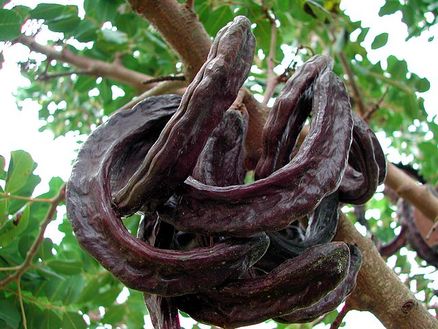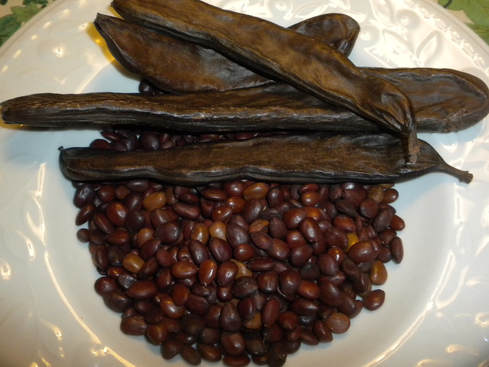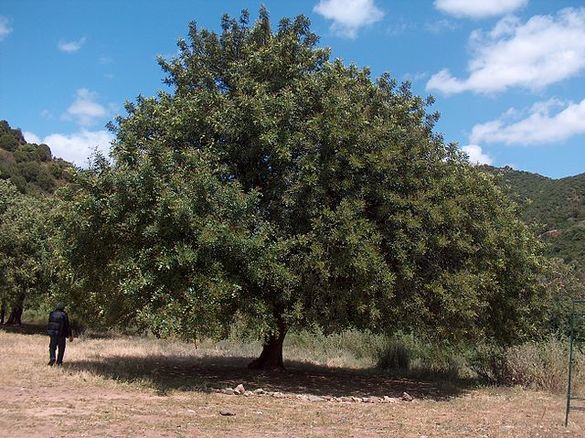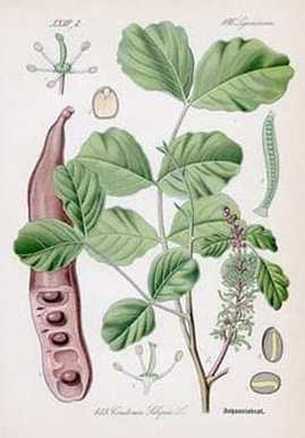Carob Tree: History, Lore and Growing Information
Ceratonia siliqua, commonly known as the Carob tree or its fruit as St. John's bread, is a species of flowering evergreen shrub or tree in the pea family, Fabaceae. It is widely cultivated for its edible legumes, and as a care-free ornamental tree in yards and city sidewalk strips. It is largely drought tolerant, pest free and disease free. It is native to the Mediterranean region. Carob is also called locust tree, as locust bean gum is traditionally extracted from its seeds, which are are extremely hard and durable. The brown carob pods contain galactomannon, a commercially valuable carbohydrate that is used as a thickener, emulsifier and stabilizer in many food products.
An ancient food and aphrodisiac. Saint John the Baptist was thought to have subsisted on carob pods in lean times, as the inner seeds are made into locust bean gum and have been called locust beans forever. Hence, which locusts were the Baptist really eating? Pods are high in protein, sugars and carbohydrates.
The Carob Tree thrives in challenging environments with little or no care whatsoever. Frost and drought tolerant. Pretty round leaves with a noticeable reddish tint to its branches. Prefers a dry, mild Mediterranean climate such as Italy, Spain, California, etc., but is tolerant of other climates once established. Beautiful ornamental tree with long brown seed pods that develop from Fall flowers. Just as the beans mature, new flowers sprout all over the tree.
Some Carob Facts:
Planting Directions:
Scarify lightly with sandpaper and soak seeds overnight before planting. Keep young sprouts watered. Full sun. Tolerates most soils, but plant in rich soil for best results.
Carob seeds can be planted and grown into mature, beautiful trees in California, Texas and Florida and other areas with a moderate climate. They prefer a warm Mediterranean climate with only mild frost in winter. Young trees are expensive to purchase, but can live for 150 years. Drought resistant, frost resistant and pest resistant. Pretty round leaves with beautiful red limbs make this tree a popular landscape item. No pests really attack the trees, but many animals, especially squirrels, enjoy eating the nutritious pods both on and off the tree, in human terms, as dining in or as a take out meal that is biodegradable.
The Ceratonia siliqua tree grows up to 10 meters (35 ft) tall. The crown is broad and semi-spherical, supported by a thick trunk with brown rough bark and sturdy branches. Leaves are 10 to 20 centimeters (3.9 to 7.9 in) long, alternate, pinnate, rounded, and may or may not have a terminal leaflet. It is frost-tolerant.
Grows to about 30-40 feet at maturity, evergreen, with a rounded branching system giving it a classic rounded tree look. You need an extension ladder to harvest pods and harvest must be timed to the right season. I also sell the seeds for planting on this website. Seeds can be extracted from pods for planting as well. Carob powder is made from the hulls only. Locust bean gum is made from the seeds.
Carob Uses:
Safe for dogs as a chocolate substitute! Broken pieces are natural dog treats, and are nibbled on by birds and mammals alike. Carob does not contain theobromine, a toxic alkaloid found in chocolate which can cause sleeplessness, tremors, restlessness, anxiety, nausea, and vomiting in humans and can be fatal to dogs and cats. This is why carob is used to make safe chocolate-flavored treats for dogs.
Each pod can contain up to 25% protein! (Protein content varies from tree to tree, as do pods.) Carob pod pieces can be used in potpourris as a fixative and for their own intoxicating chocolate fragrance. The hard, inner seeds should be removed (not sure how they do it?!) before grinding if you intend to roast and grind the pods into homemade carob powder.
Carob trees can be dioecious or monoecious, meaning some trees are male or female, while others are self-pollinating. The trees blossom in autumn (September–October) just as the mature pods are beginning to fall from the tree. The flowers are small and numerous, spirally arranged along the inflorescence axis in catkin-like racemes borne on spurs from old wood and even on the trunk (cauliflory); they are pollinated by both wind and bees. Male and female trees produce a characteristic odor during blossom, resembling semen, often considered off or obnoxious by many humans, but is favored by honey bees. This only lasts for a week or two each fall.
The fruit is a pod that can be elongated, compressed, straight or curved, and thickened at the sutures. The pods take almost a full year to develop and ripen, turning from green to brown. The ripe pods eventually fall to the ground and are eaten by various mammals, thereby dispersing the seed. Likewise, the carob powder purchased in Natural Food stores is actually the dried, ground (and roasted) pod, and not the inner seeds found inside the pod, The seeds are used to make locust bean gum, found in many modern foods.
Sometimes the seeds shake inside the pods like a musical instrument. My adventurous son Shawn, who picked many pods with me while braving injury and insect bites sitting in the tree, actually liked the pod flavor. Sort of like an ancient version of a chocolate trail bar, with many one-carat trading seeds inside instead of trading cards... I can see Frodo and Samwise unwrapping some sacred carob pods as their last meal in the shadows of Mount Doom before destroying the One Ring...OK, I am rewriting carob history...
The seeds of Ceratonia siliqua contain leucodelphinidin, a colorless chemical compound.
Carob History:
The term "carat," the unit by which gold and gem weight is measured, was derived from the ancient practice of weighing gold against the seeds of the carob tree by people in the Middle East. The system was eventually standardized, and one carat was fixed at 0.2 grams, about the weight of one carob seed.
Subsistence on carob pods is mentioned in the Talmud: Berakhot reports that Rabbi Haninah subsisted on carob pods. It is also mentioned in the New Testament, in which Matthew 3:4 reports that John the Baptist subsisted on "locusts and wild honey"; the Greek word translated "locusts" likely refers to the hanging, swinging carob pods with locust beans, rather than to jumping grasshoppers that might have only locust beans to eat in the desert. Again, in Luke 15:16; "When the Prodigal Son is in the field in spiritual and social poverty, he desires to eat the pods that he is feeding to the swine because he is suffering from starvation."
The use of the carob during a famine is likely a result of the carob tree's resilience to the harsh climate and severe drought. During a famine, the swine were given carob pods so that they would not be a burden on the farmer's limited food resources.
Carob is typically dried or roasted, and is mildly sweet. In powdered, chip, or syrup form it is used as an ingredient in cakes and cookies, and is widely used around the world as a substitute for chocolate.
Carob was eaten in Ancient Egypt. It was also a common sweetener and was used in the hieroglyph for "sweet" (nedjem). Dried carob fruit is traditionally eaten on the Jewish holiday of Tu Bishvat. Carob juice drinks are traditionally drunk during the Islamic month of Ramadan. Also, it was long believed to be an aphrodisiac.
In Cyprus, their carob syrup is known as Cyprus black gold, and is widely exported.
In Malta, a syrup (ġulepp tal-ħarrub) is also made from carob pods. A traditional sweet treat, eaten during Lent and on Good Friday, is also made from carob pods in Malta. However, carob pods were mainly used as animal fodder in the Maltese Islands, apart from times of famine or war when they formed part of the diet of many Maltese. Carob is a traditional Malta medicine for coughs and sore throat.
Carob pods were an important source of natural sugar before sugarcane and sugar beets became widely cultivated... and before the corn industry invented a drug called high fructose corn syrup which took over in America as a cheap, unnatural sweetener in almost all commercial food.
© 2011-2024 Copyright, Datura Don and White Buffalo Trading. All Rights Reserved. All Plants Preserved,.
An ancient food and aphrodisiac. Saint John the Baptist was thought to have subsisted on carob pods in lean times, as the inner seeds are made into locust bean gum and have been called locust beans forever. Hence, which locusts were the Baptist really eating? Pods are high in protein, sugars and carbohydrates.
The Carob Tree thrives in challenging environments with little or no care whatsoever. Frost and drought tolerant. Pretty round leaves with a noticeable reddish tint to its branches. Prefers a dry, mild Mediterranean climate such as Italy, Spain, California, etc., but is tolerant of other climates once established. Beautiful ornamental tree with long brown seed pods that develop from Fall flowers. Just as the beans mature, new flowers sprout all over the tree.
Some Carob Facts:
- Carob tree has a very deep tap root and can live in areas with low or infrequent rainfall. It does not do well in wet, soggy, poorly drained soil. During a drought, the tree can still produce edible fruit. Its fruit can be a valuable famine food for both people and animals. In Biblical times, animals were fed carob pods in times of famine.
- Carob can live in a wide range of temperatures: from 20 to 122 degrees F (-6 to 50 degrees C).
- Carob grows well in poor, salt-rich, rocky, sandy and heavy loam soils.
- Carob Pods, sans seeds, are ground into carob powder and roasted, a European tradition. They are used as a chocolate substitute in baked goods and candies worldwide.
- The Carob Tree is a member of the Pea Family (Leguminosae or Fabaceae). A few of its many family members are sweet peas, peanuts, soy beans and garden peas. Legumes typically fix airborne nitrogen into the soil.
- Although originally from the Middle East or the Horn of Arabia, the Carob Tree will grow wherever the soil and climate are suitable. It now grows in Australia, much of the middle and southern USA, Mexico, South America, Spain, Portugal, France, Italy, Israel, and most of Africa. It can be found all over California.
- The Carob Tree is an evergreen that grows to a height of about 50 to 60 feet (15 to 17 meters).
- The Carob Tree begins to produce fruit when it is six to 15 years old. It can live and produce fruit until it is 100 years old.
- Unlike many other members of its family it does not have colorful big flowers. It has very tiny flowers on a stalk that is attached directly to the trunk and limbs of the tree. The flowers take almost a year to develop into a sweet, chocolate colored pod.
- The Carob seed pods measure four to 12 inches long, with an average length of about six inches.
- The Carob Tree grows wild but it can also be farmed commercially. It is planted as a landscape plant in many cities in California, where it receives no care for watering, pruning, seed picking, or spraying.
- The Carob Tree requires little or no pruning and can produce fruit without fertilization or irrigation in most environments.
- The Carob Tree is virtually pest free. Animals, especially mammals and birds, eat its nutritious pods and seeds, which can contain up to 25% protein. This helps spread and release its seeds. The trees tend to be a home for small spiders, and are favored by squirrels.
Planting Directions:
Scarify lightly with sandpaper and soak seeds overnight before planting. Keep young sprouts watered. Full sun. Tolerates most soils, but plant in rich soil for best results.
Carob seeds can be planted and grown into mature, beautiful trees in California, Texas and Florida and other areas with a moderate climate. They prefer a warm Mediterranean climate with only mild frost in winter. Young trees are expensive to purchase, but can live for 150 years. Drought resistant, frost resistant and pest resistant. Pretty round leaves with beautiful red limbs make this tree a popular landscape item. No pests really attack the trees, but many animals, especially squirrels, enjoy eating the nutritious pods both on and off the tree, in human terms, as dining in or as a take out meal that is biodegradable.
The Ceratonia siliqua tree grows up to 10 meters (35 ft) tall. The crown is broad and semi-spherical, supported by a thick trunk with brown rough bark and sturdy branches. Leaves are 10 to 20 centimeters (3.9 to 7.9 in) long, alternate, pinnate, rounded, and may or may not have a terminal leaflet. It is frost-tolerant.
Grows to about 30-40 feet at maturity, evergreen, with a rounded branching system giving it a classic rounded tree look. You need an extension ladder to harvest pods and harvest must be timed to the right season. I also sell the seeds for planting on this website. Seeds can be extracted from pods for planting as well. Carob powder is made from the hulls only. Locust bean gum is made from the seeds.
Carob Uses:
Safe for dogs as a chocolate substitute! Broken pieces are natural dog treats, and are nibbled on by birds and mammals alike. Carob does not contain theobromine, a toxic alkaloid found in chocolate which can cause sleeplessness, tremors, restlessness, anxiety, nausea, and vomiting in humans and can be fatal to dogs and cats. This is why carob is used to make safe chocolate-flavored treats for dogs.
Each pod can contain up to 25% protein! (Protein content varies from tree to tree, as do pods.) Carob pod pieces can be used in potpourris as a fixative and for their own intoxicating chocolate fragrance. The hard, inner seeds should be removed (not sure how they do it?!) before grinding if you intend to roast and grind the pods into homemade carob powder.
Carob trees can be dioecious or monoecious, meaning some trees are male or female, while others are self-pollinating. The trees blossom in autumn (September–October) just as the mature pods are beginning to fall from the tree. The flowers are small and numerous, spirally arranged along the inflorescence axis in catkin-like racemes borne on spurs from old wood and even on the trunk (cauliflory); they are pollinated by both wind and bees. Male and female trees produce a characteristic odor during blossom, resembling semen, often considered off or obnoxious by many humans, but is favored by honey bees. This only lasts for a week or two each fall.
The fruit is a pod that can be elongated, compressed, straight or curved, and thickened at the sutures. The pods take almost a full year to develop and ripen, turning from green to brown. The ripe pods eventually fall to the ground and are eaten by various mammals, thereby dispersing the seed. Likewise, the carob powder purchased in Natural Food stores is actually the dried, ground (and roasted) pod, and not the inner seeds found inside the pod, The seeds are used to make locust bean gum, found in many modern foods.
Sometimes the seeds shake inside the pods like a musical instrument. My adventurous son Shawn, who picked many pods with me while braving injury and insect bites sitting in the tree, actually liked the pod flavor. Sort of like an ancient version of a chocolate trail bar, with many one-carat trading seeds inside instead of trading cards... I can see Frodo and Samwise unwrapping some sacred carob pods as their last meal in the shadows of Mount Doom before destroying the One Ring...OK, I am rewriting carob history...
The seeds of Ceratonia siliqua contain leucodelphinidin, a colorless chemical compound.
Carob History:
The term "carat," the unit by which gold and gem weight is measured, was derived from the ancient practice of weighing gold against the seeds of the carob tree by people in the Middle East. The system was eventually standardized, and one carat was fixed at 0.2 grams, about the weight of one carob seed.
Subsistence on carob pods is mentioned in the Talmud: Berakhot reports that Rabbi Haninah subsisted on carob pods. It is also mentioned in the New Testament, in which Matthew 3:4 reports that John the Baptist subsisted on "locusts and wild honey"; the Greek word translated "locusts" likely refers to the hanging, swinging carob pods with locust beans, rather than to jumping grasshoppers that might have only locust beans to eat in the desert. Again, in Luke 15:16; "When the Prodigal Son is in the field in spiritual and social poverty, he desires to eat the pods that he is feeding to the swine because he is suffering from starvation."
The use of the carob during a famine is likely a result of the carob tree's resilience to the harsh climate and severe drought. During a famine, the swine were given carob pods so that they would not be a burden on the farmer's limited food resources.
Carob is typically dried or roasted, and is mildly sweet. In powdered, chip, or syrup form it is used as an ingredient in cakes and cookies, and is widely used around the world as a substitute for chocolate.
Carob was eaten in Ancient Egypt. It was also a common sweetener and was used in the hieroglyph for "sweet" (nedjem). Dried carob fruit is traditionally eaten on the Jewish holiday of Tu Bishvat. Carob juice drinks are traditionally drunk during the Islamic month of Ramadan. Also, it was long believed to be an aphrodisiac.
In Cyprus, their carob syrup is known as Cyprus black gold, and is widely exported.
In Malta, a syrup (ġulepp tal-ħarrub) is also made from carob pods. A traditional sweet treat, eaten during Lent and on Good Friday, is also made from carob pods in Malta. However, carob pods were mainly used as animal fodder in the Maltese Islands, apart from times of famine or war when they formed part of the diet of many Maltese. Carob is a traditional Malta medicine for coughs and sore throat.
Carob pods were an important source of natural sugar before sugarcane and sugar beets became widely cultivated... and before the corn industry invented a drug called high fructose corn syrup which took over in America as a cheap, unnatural sweetener in almost all commercial food.
© 2011-2024 Copyright, Datura Don and White Buffalo Trading. All Rights Reserved. All Plants Preserved,.




